DNP-815: Orem’s Self-Care Model for Improved Nursing Practice
VerifiedAdded on 2023/04/05
|7
|1300
|493
Report
AI Summary
This report provides a comprehensive analysis of Dorothea E. Orem's Self-Care Model and its application in nursing practice. It translates the model's components, explores its concepts, and justifies its importance in nursing. The report evaluates the conceptual-theoretical-empirical linkages, discusses the theory's focus on patient self-care, and identifies universal self-care requirements. Empirical indicators used to test the theory are evaluated, along with research findings related to self-care deficits and the supportive role of nurses. The utility and soundness of Orem's theory are discussed, and a sample nursing care plan applying the model is presented, illustrating its practical application in enhancing patient well-being. This assignment is available on Desklib, a platform offering study tools and solved assignments for students.
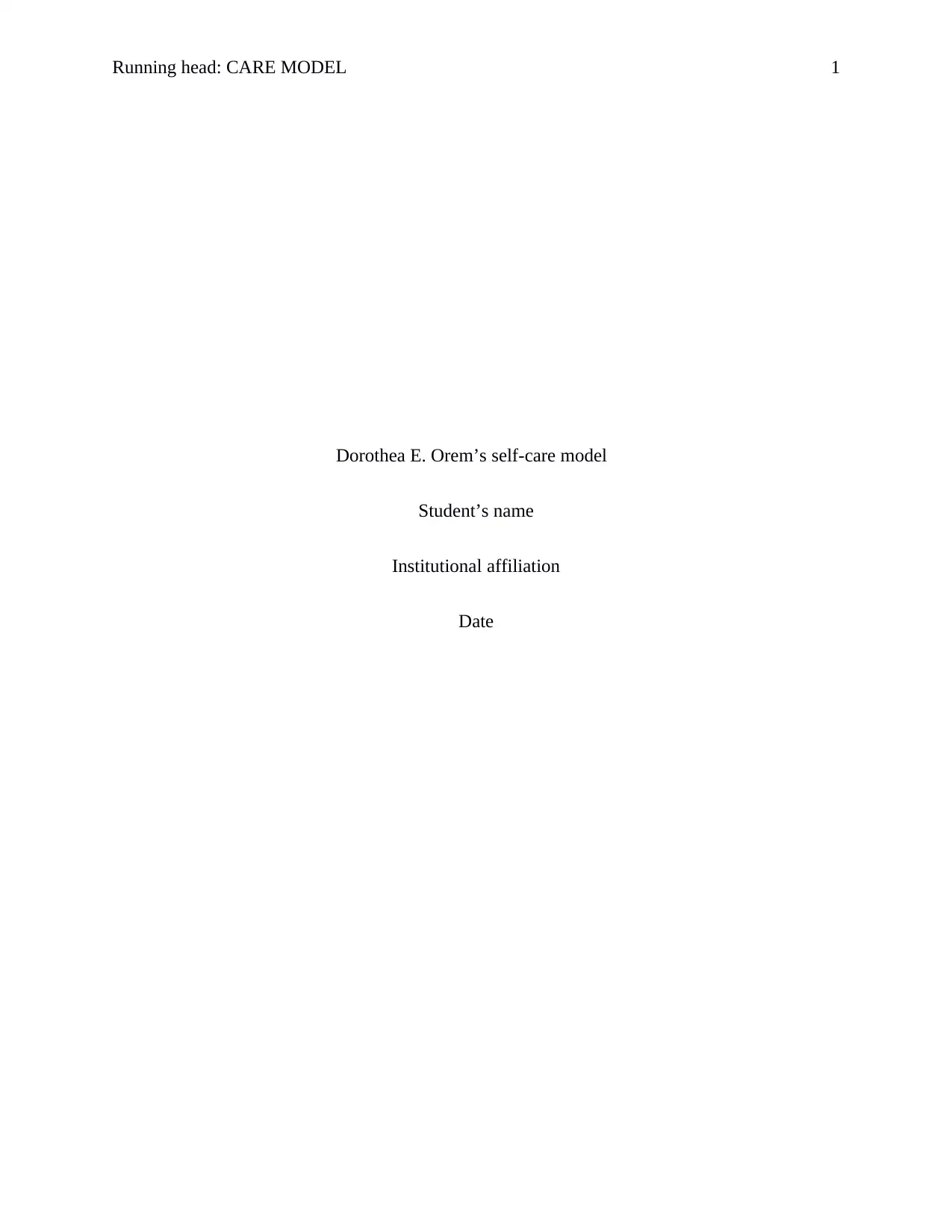
Running head: CARE MODEL 1
Dorothea E. Orem’s self-care model
Student’s name
Institutional affiliation
Date
Dorothea E. Orem’s self-care model
Student’s name
Institutional affiliation
Date
Paraphrase This Document
Need a fresh take? Get an instant paraphrase of this document with our AI Paraphraser

CARE MODEL 2
Dorothea E. Orem’s Self-care Model.
Recently, nurses have been advocating for the use of the conceptual models from the
non-nursing discipline. Nurses and students from varied levels of qualification have been
rejecting nursing models (Crotty, 2010). This is due to lack of understanding of these conceptual
models and their application to nursing Quality Improvement (QI) projects, nursing research and
overall nursing practices. A conceptual model is a conception that can be used to study an
occurrence (Powell-Morse, 2019). Most importantly, a conceptual model gives the actual ideas
for the phenomena being studied. However, all conceptual models are theories irrespective of
how tentative they might seem (Fawcett, 2013). This paper will provide a practical guide on the
general perspectives of Orem’s model by translating the components therein. It will give a
thorough dig into the concepts of the model and justify how indispensable it is in all nursing
practices. An actual translation, as well as a comprehensive framework of the content in this
model, will be also outlined. It will also include a sample draft of how a nurse can apply the
concept of the Orem theory in real practice.
An example of the application of the theory is the Green (2012) approach. Green gave an
explanation of how school nurses can apply the concept in the Orem theory to improve
intervention for school-aged children who have a guardian-reported behavioral, medical or other
health conditions that have led to a needing for special medical care. In the explanation, Green
examined the case of a school child born immaturely and diagnosed with asthma (Pulcini,
DeSisto, McIntyre & Dowd, 2011). Evaluation of this case in relation to the Orem theory was
done on the linkages or relational prepositions of the theory. One concept of Orem’s conceptual
model is Professional-technological system of nursing practice and its relation to self-care
(Younas, 2017). The case was focused on two relational concepts of Orem’s theory. The first is
Dorothea E. Orem’s Self-care Model.
Recently, nurses have been advocating for the use of the conceptual models from the
non-nursing discipline. Nurses and students from varied levels of qualification have been
rejecting nursing models (Crotty, 2010). This is due to lack of understanding of these conceptual
models and their application to nursing Quality Improvement (QI) projects, nursing research and
overall nursing practices. A conceptual model is a conception that can be used to study an
occurrence (Powell-Morse, 2019). Most importantly, a conceptual model gives the actual ideas
for the phenomena being studied. However, all conceptual models are theories irrespective of
how tentative they might seem (Fawcett, 2013). This paper will provide a practical guide on the
general perspectives of Orem’s model by translating the components therein. It will give a
thorough dig into the concepts of the model and justify how indispensable it is in all nursing
practices. An actual translation, as well as a comprehensive framework of the content in this
model, will be also outlined. It will also include a sample draft of how a nurse can apply the
concept of the Orem theory in real practice.
An example of the application of the theory is the Green (2012) approach. Green gave an
explanation of how school nurses can apply the concept in the Orem theory to improve
intervention for school-aged children who have a guardian-reported behavioral, medical or other
health conditions that have led to a needing for special medical care. In the explanation, Green
examined the case of a school child born immaturely and diagnosed with asthma (Pulcini,
DeSisto, McIntyre & Dowd, 2011). Evaluation of this case in relation to the Orem theory was
done on the linkages or relational prepositions of the theory. One concept of Orem’s conceptual
model is Professional-technological system of nursing practice and its relation to self-care
(Younas, 2017). The case was focused on two relational concepts of Orem’s theory. The first is
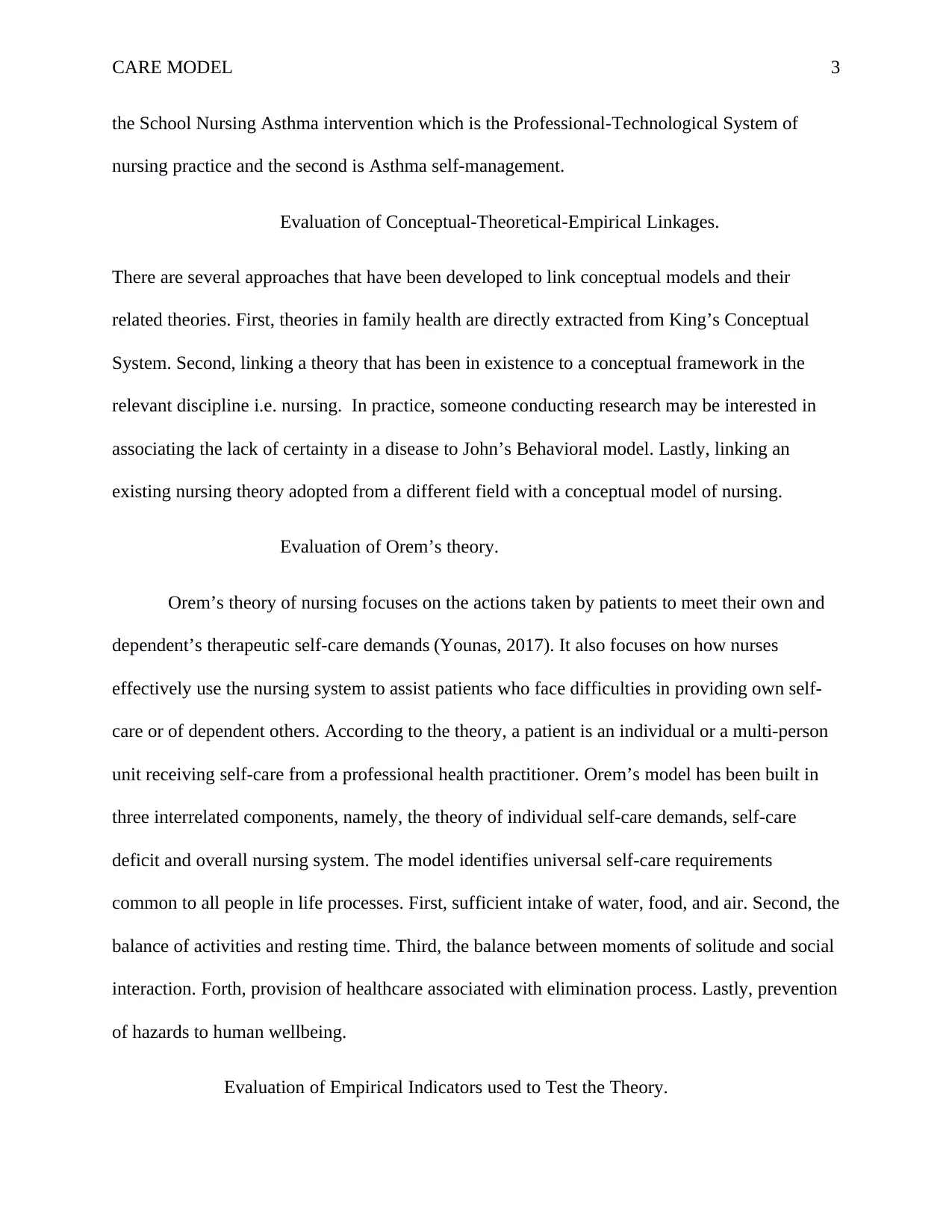
CARE MODEL 3
the School Nursing Asthma intervention which is the Professional-Technological System of
nursing practice and the second is Asthma self-management.
Evaluation of Conceptual-Theoretical-Empirical Linkages.
There are several approaches that have been developed to link conceptual models and their
related theories. First, theories in family health are directly extracted from King’s Conceptual
System. Second, linking a theory that has been in existence to a conceptual framework in the
relevant discipline i.e. nursing. In practice, someone conducting research may be interested in
associating the lack of certainty in a disease to John’s Behavioral model. Lastly, linking an
existing nursing theory adopted from a different field with a conceptual model of nursing.
Evaluation of Orem’s theory.
Orem’s theory of nursing focuses on the actions taken by patients to meet their own and
dependent’s therapeutic self-care demands (Younas, 2017). It also focuses on how nurses
effectively use the nursing system to assist patients who face difficulties in providing own self-
care or of dependent others. According to the theory, a patient is an individual or a multi-person
unit receiving self-care from a professional health practitioner. Orem’s model has been built in
three interrelated components, namely, the theory of individual self-care demands, self-care
deficit and overall nursing system. The model identifies universal self-care requirements
common to all people in life processes. First, sufficient intake of water, food, and air. Second, the
balance of activities and resting time. Third, the balance between moments of solitude and social
interaction. Forth, provision of healthcare associated with elimination process. Lastly, prevention
of hazards to human wellbeing.
Evaluation of Empirical Indicators used to Test the Theory.
the School Nursing Asthma intervention which is the Professional-Technological System of
nursing practice and the second is Asthma self-management.
Evaluation of Conceptual-Theoretical-Empirical Linkages.
There are several approaches that have been developed to link conceptual models and their
related theories. First, theories in family health are directly extracted from King’s Conceptual
System. Second, linking a theory that has been in existence to a conceptual framework in the
relevant discipline i.e. nursing. In practice, someone conducting research may be interested in
associating the lack of certainty in a disease to John’s Behavioral model. Lastly, linking an
existing nursing theory adopted from a different field with a conceptual model of nursing.
Evaluation of Orem’s theory.
Orem’s theory of nursing focuses on the actions taken by patients to meet their own and
dependent’s therapeutic self-care demands (Younas, 2017). It also focuses on how nurses
effectively use the nursing system to assist patients who face difficulties in providing own self-
care or of dependent others. According to the theory, a patient is an individual or a multi-person
unit receiving self-care from a professional health practitioner. Orem’s model has been built in
three interrelated components, namely, the theory of individual self-care demands, self-care
deficit and overall nursing system. The model identifies universal self-care requirements
common to all people in life processes. First, sufficient intake of water, food, and air. Second, the
balance of activities and resting time. Third, the balance between moments of solitude and social
interaction. Forth, provision of healthcare associated with elimination process. Lastly, prevention
of hazards to human wellbeing.
Evaluation of Empirical Indicators used to Test the Theory.
⊘ This is a preview!⊘
Do you want full access?
Subscribe today to unlock all pages.

Trusted by 1+ million students worldwide

CARE MODEL 4
Empirical indicators are the tools and procedures used to assess a theoretical concept
(2019). Below are the indicators that are used in the application of the Orem theory. First, the
nursing agency is closely related to nursing agency power in that the component of nursing
agency power greatly influences the ability to perform nursing. Second, basic conditioning
factors like gender, family system and age are related to self-care agency. Third, Professional-
Technological System of nursing practice impacts both self-care and self-care agency. Fourth,
self-care is related to overall human well-being. Fifth, self-care agency is positively linked to
self-care. Lastly, environmental dimensions i.e. chemical, physical, biological and social
economic cultural features are interrelated.
Evaluation of research finding.
From Orem’s model, the theory of self-care deficit is the main concern. For an individual
to perform proper self-care, the environment should be supportive. The nurse is therefore
required to assist the patients in acquiring their optimal well-being (Felix, 2009). The practice of
the model starts from bedside swallowing evaluation. This evaluates the ability of the patients to
swallow the administered medication. The health care provider should guide the patient on how
to use health-related technologies to boost self-care at home. Learning to help the patients switch
focus from his or her demanding domestic duties and take responsibility on less strenuous duties.
The need for support from others means that a person should seek the company of family and
friends to avoid solitude. Supporting psychologically means that the health care provider should
be someone who listens and is constantly engaged in bringing things that support the patient
during the treatment (Ellis, E., Orehek, E. and Ferrer, R. (2019).
Utility and Soundness of the Theory.
Empirical indicators are the tools and procedures used to assess a theoretical concept
(2019). Below are the indicators that are used in the application of the Orem theory. First, the
nursing agency is closely related to nursing agency power in that the component of nursing
agency power greatly influences the ability to perform nursing. Second, basic conditioning
factors like gender, family system and age are related to self-care agency. Third, Professional-
Technological System of nursing practice impacts both self-care and self-care agency. Fourth,
self-care is related to overall human well-being. Fifth, self-care agency is positively linked to
self-care. Lastly, environmental dimensions i.e. chemical, physical, biological and social
economic cultural features are interrelated.
Evaluation of research finding.
From Orem’s model, the theory of self-care deficit is the main concern. For an individual
to perform proper self-care, the environment should be supportive. The nurse is therefore
required to assist the patients in acquiring their optimal well-being (Felix, 2009). The practice of
the model starts from bedside swallowing evaluation. This evaluates the ability of the patients to
swallow the administered medication. The health care provider should guide the patient on how
to use health-related technologies to boost self-care at home. Learning to help the patients switch
focus from his or her demanding domestic duties and take responsibility on less strenuous duties.
The need for support from others means that a person should seek the company of family and
friends to avoid solitude. Supporting psychologically means that the health care provider should
be someone who listens and is constantly engaged in bringing things that support the patient
during the treatment (Ellis, E., Orehek, E. and Ferrer, R. (2019).
Utility and Soundness of the Theory.
Paraphrase This Document
Need a fresh take? Get an instant paraphrase of this document with our AI Paraphraser
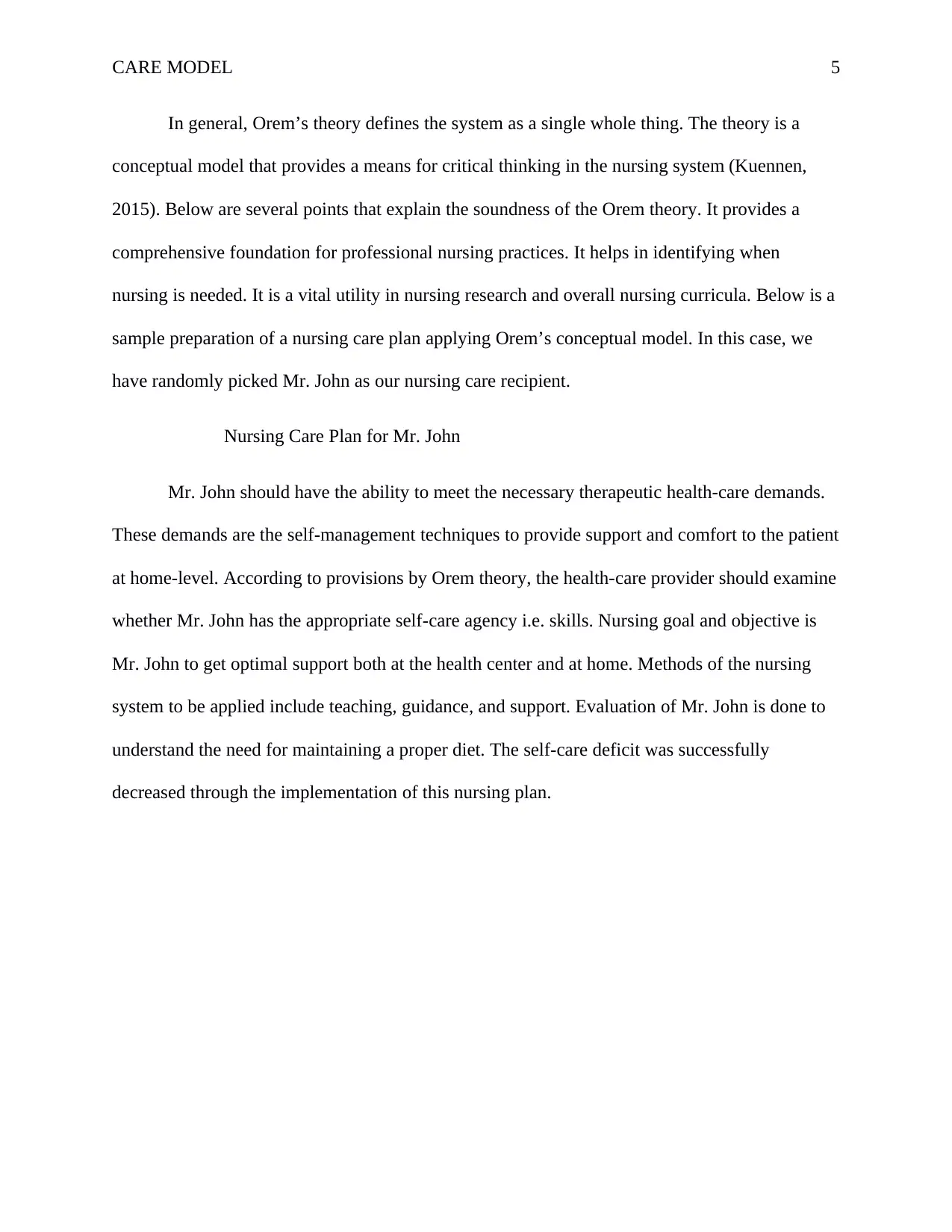
CARE MODEL 5
In general, Orem’s theory defines the system as a single whole thing. The theory is a
conceptual model that provides a means for critical thinking in the nursing system (Kuennen,
2015). Below are several points that explain the soundness of the Orem theory. It provides a
comprehensive foundation for professional nursing practices. It helps in identifying when
nursing is needed. It is a vital utility in nursing research and overall nursing curricula. Below is a
sample preparation of a nursing care plan applying Orem’s conceptual model. In this case, we
have randomly picked Mr. John as our nursing care recipient.
Nursing Care Plan for Mr. John
Mr. John should have the ability to meet the necessary therapeutic health-care demands.
These demands are the self-management techniques to provide support and comfort to the patient
at home-level. According to provisions by Orem theory, the health-care provider should examine
whether Mr. John has the appropriate self-care agency i.e. skills. Nursing goal and objective is
Mr. John to get optimal support both at the health center and at home. Methods of the nursing
system to be applied include teaching, guidance, and support. Evaluation of Mr. John is done to
understand the need for maintaining a proper diet. The self-care deficit was successfully
decreased through the implementation of this nursing plan.
In general, Orem’s theory defines the system as a single whole thing. The theory is a
conceptual model that provides a means for critical thinking in the nursing system (Kuennen,
2015). Below are several points that explain the soundness of the Orem theory. It provides a
comprehensive foundation for professional nursing practices. It helps in identifying when
nursing is needed. It is a vital utility in nursing research and overall nursing curricula. Below is a
sample preparation of a nursing care plan applying Orem’s conceptual model. In this case, we
have randomly picked Mr. John as our nursing care recipient.
Nursing Care Plan for Mr. John
Mr. John should have the ability to meet the necessary therapeutic health-care demands.
These demands are the self-management techniques to provide support and comfort to the patient
at home-level. According to provisions by Orem theory, the health-care provider should examine
whether Mr. John has the appropriate self-care agency i.e. skills. Nursing goal and objective is
Mr. John to get optimal support both at the health center and at home. Methods of the nursing
system to be applied include teaching, guidance, and support. Evaluation of Mr. John is done to
understand the need for maintaining a proper diet. The self-care deficit was successfully
decreased through the implementation of this nursing plan.
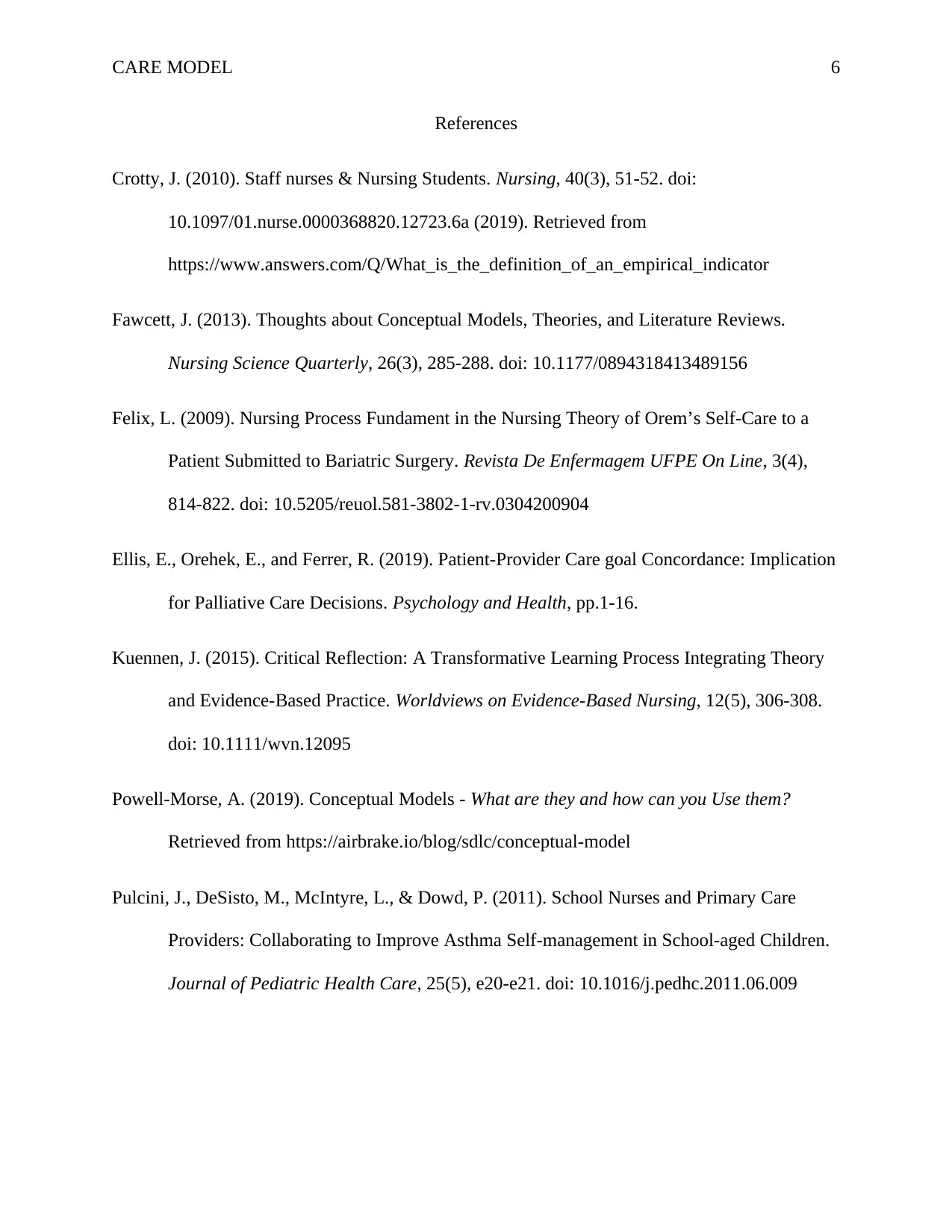
CARE MODEL 6
References
Crotty, J. (2010). Staff nurses & Nursing Students. Nursing, 40(3), 51-52. doi:
10.1097/01.nurse.0000368820.12723.6a (2019). Retrieved from
https://www.answers.com/Q/What_is_the_definition_of_an_empirical_indicator
Fawcett, J. (2013). Thoughts about Conceptual Models, Theories, and Literature Reviews.
Nursing Science Quarterly, 26(3), 285-288. doi: 10.1177/0894318413489156
Felix, L. (2009). Nursing Process Fundament in the Nursing Theory of Orem’s Self-Care to a
Patient Submitted to Bariatric Surgery. Revista De Enfermagem UFPE On Line, 3(4),
814-822. doi: 10.5205/reuol.581-3802-1-rv.0304200904
Ellis, E., Orehek, E., and Ferrer, R. (2019). Patient-Provider Care goal Concordance: Implication
for Palliative Care Decisions. Psychology and Health, pp.1-16.
Kuennen, J. (2015). Critical Reflection: A Transformative Learning Process Integrating Theory
and Evidence-Based Practice. Worldviews on Evidence-Based Nursing, 12(5), 306-308.
doi: 10.1111/wvn.12095
Powell-Morse, A. (2019). Conceptual Models - What are they and how can you Use them?
Retrieved from https://airbrake.io/blog/sdlc/conceptual-model
Pulcini, J., DeSisto, M., McIntyre, L., & Dowd, P. (2011). School Nurses and Primary Care
Providers: Collaborating to Improve Asthma Self-management in School-aged Children.
Journal of Pediatric Health Care, 25(5), e20-e21. doi: 10.1016/j.pedhc.2011.06.009
References
Crotty, J. (2010). Staff nurses & Nursing Students. Nursing, 40(3), 51-52. doi:
10.1097/01.nurse.0000368820.12723.6a (2019). Retrieved from
https://www.answers.com/Q/What_is_the_definition_of_an_empirical_indicator
Fawcett, J. (2013). Thoughts about Conceptual Models, Theories, and Literature Reviews.
Nursing Science Quarterly, 26(3), 285-288. doi: 10.1177/0894318413489156
Felix, L. (2009). Nursing Process Fundament in the Nursing Theory of Orem’s Self-Care to a
Patient Submitted to Bariatric Surgery. Revista De Enfermagem UFPE On Line, 3(4),
814-822. doi: 10.5205/reuol.581-3802-1-rv.0304200904
Ellis, E., Orehek, E., and Ferrer, R. (2019). Patient-Provider Care goal Concordance: Implication
for Palliative Care Decisions. Psychology and Health, pp.1-16.
Kuennen, J. (2015). Critical Reflection: A Transformative Learning Process Integrating Theory
and Evidence-Based Practice. Worldviews on Evidence-Based Nursing, 12(5), 306-308.
doi: 10.1111/wvn.12095
Powell-Morse, A. (2019). Conceptual Models - What are they and how can you Use them?
Retrieved from https://airbrake.io/blog/sdlc/conceptual-model
Pulcini, J., DeSisto, M., McIntyre, L., & Dowd, P. (2011). School Nurses and Primary Care
Providers: Collaborating to Improve Asthma Self-management in School-aged Children.
Journal of Pediatric Health Care, 25(5), e20-e21. doi: 10.1016/j.pedhc.2011.06.009
⊘ This is a preview!⊘
Do you want full access?
Subscribe today to unlock all pages.

Trusted by 1+ million students worldwide
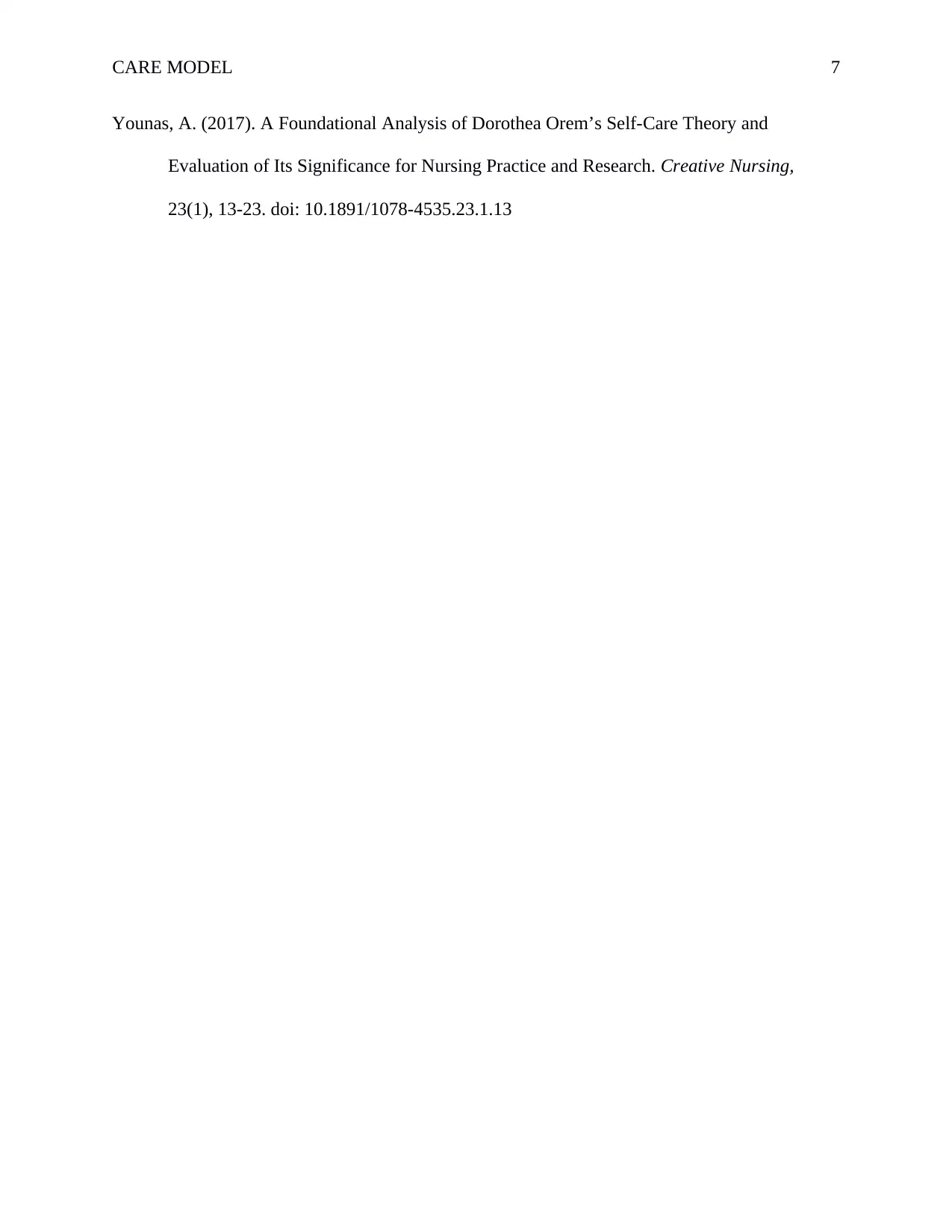
CARE MODEL 7
Younas, A. (2017). A Foundational Analysis of Dorothea Orem’s Self-Care Theory and
Evaluation of Its Significance for Nursing Practice and Research. Creative Nursing,
23(1), 13-23. doi: 10.1891/1078-4535.23.1.13
Younas, A. (2017). A Foundational Analysis of Dorothea Orem’s Self-Care Theory and
Evaluation of Its Significance for Nursing Practice and Research. Creative Nursing,
23(1), 13-23. doi: 10.1891/1078-4535.23.1.13
1 out of 7
Related Documents
Your All-in-One AI-Powered Toolkit for Academic Success.
+13062052269
info@desklib.com
Available 24*7 on WhatsApp / Email
![[object Object]](/_next/static/media/star-bottom.7253800d.svg)
Unlock your academic potential
Copyright © 2020–2025 A2Z Services. All Rights Reserved. Developed and managed by ZUCOL.





